'El maestro' Tabarez teaches his Copa rivals a tactical lesson
Most managers who had just taken a country of only 3.5 million people to the World Cup semi-finals at the age of 63 would have called it a day - they would have assumed the only way was down.
But Oscar Tabarezâ decision to continue was vindicated completely by Sunday nightâÂÂs Copa America victory in Buenos Aires.
Uruguay are now the most successful side in Copa America history, and barring a 48 minute spell against Argentina, they rarely looked troubled as they marched to their 15th continental crown.
Their opening draw against Peru may have been seen as a shock, but in the context of the tournament, with Sergio Markarian (a Uruguayan) leading his side to third place in the Copa, it stands up as a reasonable result.
Having had his first involvement with the national set-up in 1983 as manager of the under-20 side, Tabarezâ long term plan following a poor 1980s for âÂÂla celesteâ is finally starting to reap its rewards, and the system has produced some excellent younger players to blend with the talented older generation.
'El maestro' stays cool as those around him go thoroughly potty
It is easy to see how he earned the nickname âÂÂel maestroâ (the teacher), his masterful approach to the all-round development of Uruguayan football as an overseer has been an enormous factor in propelling the tiny nation back to the upper echelons of world football. Similarly, this tournament has served to exhibit his superlative skills as a touchline manager.
The best features, fun and footballing quizzes, straight to your inbox every week.
The previously mentioned difficult 48 minutes followed Diego Perezâ red card in the quarter-final against the hosts. A first half dismissal should have all but condemned any side up against such big tournament favourites, but the key was surviving until half-time, once Tabarez had his players in the dressing room there would be a chance for him to re-arrange his side to cope with the numerical disadvantage.
Of course, he was helped in this instance by being up against a coach with all of the tactical nous of a watermelon, but once his side prevailed on penalties against Argentina, Uruguay themselves became tournament favourites and went on to triumph in emphatic fashion.
Boasting a delicate blend of defensive play, âÂÂgarra charrúaâ (the indigenous sprit/fight) and some world-class attacking players, Tabarez formed a team that was effective and also tactically flexible.
There are so few sides in world football that could so seamlessly switch between a back four and back three in the way that the Uruguayans have done in their last two major tournaments, and the credit for this must be attributed to âÂÂthe teacherâ as well as the players who could adapt so readily.
The key to the side was always its defence and industry: even in the final, only two attacking players started the game, and of the midfield four, two were defensive midfielders and another a full-back shunted forwards. Conceding just three goals in their six tournament games, Tabarez relied on the superstar forwards at his disposal to provide their goals and they did so, if not quite as spectacularly as their 2010 campaign in South Africa.
His tactical masterstroke in the final against Paraguay was the high pressing on opposing playmaker Nestor Ortigoza, who had been a dangerous player for the âÂÂalbirrojaâ in their earlier fixtures.
By harrying and hampering the San Lorenzo midfielder, Uruguay stifled the Paraguayansâ ability to play and after going 2-0 up, they never looked back.
Another key factor was the bigger pitch at âÂÂel Monumentalâ in Buenos Aires, which meant ParaguayâÂÂs narrow and defensive gameplan was partially undone by the larger areas the players had to cover, very different to the small provincial grounds in Cordoba and Salta where it had proved easier to sit tight in the face of attack.
Few could argue that Uruguay didnâÂÂt deserve this Copa America win, and fewer could have argued that runners-up Paraguay did deserve to.
They finished the competition without winning a game in 90 or even 120 minutes and typified the defensive mindsets that teams have adopted throughout this tournament.
While it may be remembered for Brazil and ArgentinaâÂÂs underachievers, or Venezuela and Peru coming to the fore, the 2011 Copa America should be remembered for a historic Uruguay victory where âÂÂel maestroâ taught his opposing managers a tactical lesson.
